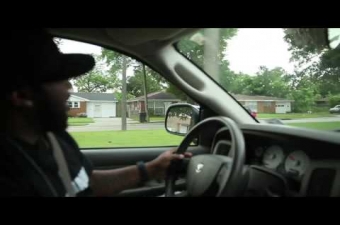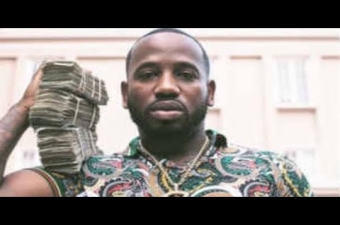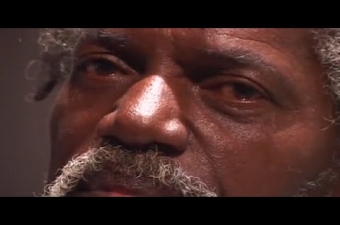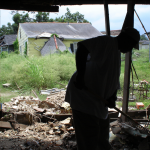St. Bernard Public Housing Development
3601 St. Bernard AvenueNew Orleans LA 70122
The St. Bernard Public Housing Development in the Seventh Ward played a key role in the birth of modern brass band and bounce music, two dominant cultural forces in New Orleans over the last fifty years. The complex was home to generations of the city’s top musical talent and remains a cultural touchstone even after its demolition in 2007.
Made up of low-rise brick buildings arranged around courtyards, the St. Bernard opened to Black residents only in 1942, and expanded in 1953 to include 1,460 apartments. Among the early residents was the Bocage family, whose members had been making music since the dawn of jazz. In the rhythm and blues era, Edwin Bocage, better known as Eddie Bo, drew on New Orleans’ barrelhouse piano style, his studies at the Grunewald School of Music, and his experience backing the stars of the Chitlin Circuit to become one of the most versatile and productive pianists and composers in New Orleans. In the 1960s, he expanded from R&B to proto-funk, producing classics like “Hook and Sling.”
In 1970, a reverend at a church two blocks from the St. Bernard tapped the venerable jazzman Danny Barker, who lived around the corner, to create a brass band for kids in the neighborhood. The Fairview Baptist Church Christian Marching Band paraded through the St. Bernard’s courtyards on Easter, and soon attracted young musicians from across the city, galvanizing a revival of New Orleans’ brass band tradition.
Alumni of the Fairview band founded several new groups in the 70s, such as the Hurricane and Dirty Dozen Brass Bands, both featuring St. Bernard resident Gregory Davis on trumpet. Davis became the leader of the Dirty Dozen, which brought a new raft of influences to the repertoire, including bebop, funk, and R&B (as a teenager, Davis had played behind Jean Knight, of “Mr. Big Stuff” fame). Their style took off, from second lines to concert halls around the world, and has influenced every New Orleans brass band to follow them.
Gospel singer Christine Myles raised ten children in the St. Bernard, including her son Raymond, who started performing in 1963 at age 5, and who sang at Mahalia Jackson’s funeral in New Orleans in 1972. According to Jonathan Tabak in OffBeat, “In one of [Raymond’s] earliest memories growing up in the St. Bernard housing project, he remembers climbing to the top of the bench on his porch and imagining that the courtyard was full of hundreds of people swaying to the sound of his voice.”
Myles fulfilled that vision in the 1980s and 90s, when he was one of the city’s brightest gospel stars, praised for his soulful vocals and his direction of the choir at Greater St. Stephen’s Baptist Church. He also endured abuse for being gay, though he refused to tamp down what some called his “flamboyant” style. In 1997 Myles raised his profile with the album “Heaven is the Place,” produced by the great Allen Toussaint, but the following year he was shot and killed in a robbery in his car. His murder at age 40 shocked the city, and inspired Mayor Marc Morial to sue gun manufacturers for damages (the lawsuit, emulated by municipalities across the country, was unsuccessful).
The Rise of Bounce
In the 1980s, DJs often played music at block parties in the St. Bernard. One of them was DJ Irv, born Irvin Phillips, who lived in the complex with his mother and two sisters. His sister Loren, who would publish a magazine covering New Orleans hip hop called Da R.U.D.E., recalls him making his own DJ rig to mix records on balconies overlooking the developments’ courtyards—a story relayed in the book Beyond the Bricks by Daron Crawford and Pernell Russell.
In 1991, DJ Irv’s mixing spawned bounce, a dance-oriented subgenre of hip hop. The seminal moment came when he looped a beat that became known as the “Triggerman” from a record by the Showboys called “Drag Rap.” DJ Irv made the beat the foundation of a song called “Wha Dey At” with MC TT Tucker, which an ensuing wave of artists used as a blueprint for filling dancefloors. DJ Irv was incarcerated as the song catalyzed the growth of New Orleans hip hop in the 1990s. Upon his release he moved back into the St. Bernard, where he was shot and killed in 2001 at age 32.
One of the artists who built on DJ Irv’s work was Rick Bickham, known as rapper Ricky B. In 1994 he put out a tape with two canonical bounce hits, “Shake It Fo Ya Hood” and “Yall Holla,” which both reference his upbringing in the St. Bernard. The latter uses a sample of a sousaphone line by Philip Frazier of the Rebirth Brass Band (who grew up emulating the bass lines of the Dirty Dozen), underscoring the cross-fertilization of modern brass band music and bounce.
Post-Katrina Developments
When Hurricane Katrina approached in 2005, 20-year-old Theodore Jones III, who rapped as Young Greatness, hunkered down in the St. Bernard, where he grew up. For decades New Orleanians sought shelter from storms in the city’s old brick public housing, which always stood up to the worst wind and rain. The levees failures, though, inundated the first-floor units of the St. Bernard. Young Greatness had to swim to safety before being rescued. The experience led him to devote himself to music, and he scored a breakthrough hit with “Moolah” in 2016. With his star on the rise in 2018 he was shot and killed in a robbery outside of a Waffle House on Elysian Fields Avenue, another stunning loss for the music community.
By then, despite protests by displaced residents, the city had bulldozed the St. Bernard and replaced it with a mixed-income development called Columbia Parc. Among the many forced to find housing elsewhere were trombonist Joseph Maize, Jr. and bass drummer Darren Towns of the TBC Brass Band (the group’s full name is To Be Continued, a reference to its perpetuation of the brass band tradition). TBC wrote a song addressed to New Orleans mayor Ray Nagin, who’d backed the demolition: “Nagin (Give Me My Projects Back).”
Columbia Parc, a private development, prohibits the kind of parades that helped launch the Fairview band, but the Big 7 Social Aid and Pleasure Club, born in the St. Bernard, still holds its annual second line on the street alongside it. As club president Ed Buckner told journalist Katy Reckdahl, “You can’t take the spirit from the land… And until the day I die, the Big 7 will celebrate the spirit that remains here.”
Read more about the role of public housing in the development of New Orleans music.
Videos

Edward Buckner of the Original Big 7 Social Aid and Pleasure Club recounts the musical life of the St. Bernard and discusses his work as a cultural advocate in New Orleans.
Video by A Closer Walk.
Edward Buckner of the Original Big 7 Social Aid and Pleasure Club recounts the musical life of the St. Bernard and discusses his work as a cultural advocate in New Orleans.

Gregory Davis of the Dirty Dozen Brass Band, who grew up in the St. Bernard, reflects on his musical life and career.
Gregory Davis of the Dirty Dozen Brass Band, who grew up in the St. Bernard, reflects on his musical life and career.

St. Bernard resident Raymond Myles and the RAMS perform "Jesus, the Baddest Man in Town," a track on the 1995 live album Heaven is the Place.
Video posted by 10JLB.
St. Bernard resident Raymond Myles and the RAMS perform "Jesus, the Baddest Man in Town," a track on the 1995 live album Heaven is the Place.

Bounce hero Ricky B takes a tour through the redeveloped site of the St. Bernard, where he grew up.
Video by Nola.com.
Bounce hero Ricky B takes a tour through the redeveloped site of the St. Bernard, where he grew up.

A profile of Young Greatness, including his early years in the St. Bernard, his rise in the hip hop world, and his tragic death in 2018.
Video by What's The Numbers TV.
A profile of Young Greatness, including his early years in the St. Bernard, his rise in the hip hop world, and his tragic death in 2018.

"Have I Got a Witness," a 45-minute documentary about the closure of the St. Bernard after Hurricane Katrina by Benjamin Greené, Brooke Shuman, and P. Corwin Lamm.
Video posted by pcorwinlamm
.
"Have I Got a Witness," a 45-minute documentary about the closure of the St. Bernard after Hurricane Katrina by Benjamin Greené, Brooke Shuman, and P. Corwin Lamm.
Images

















